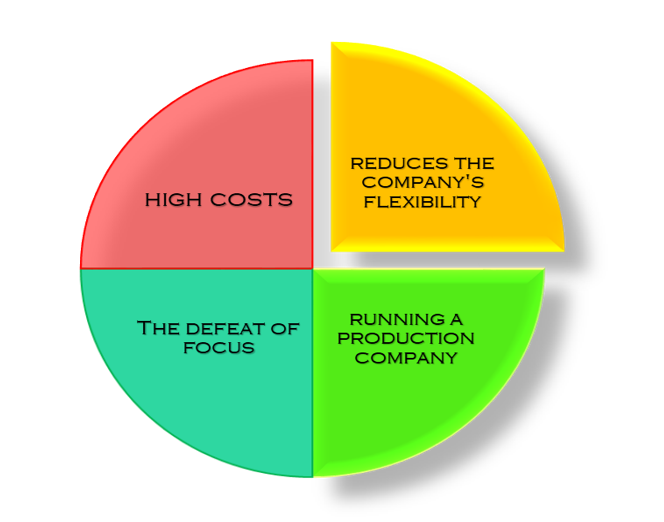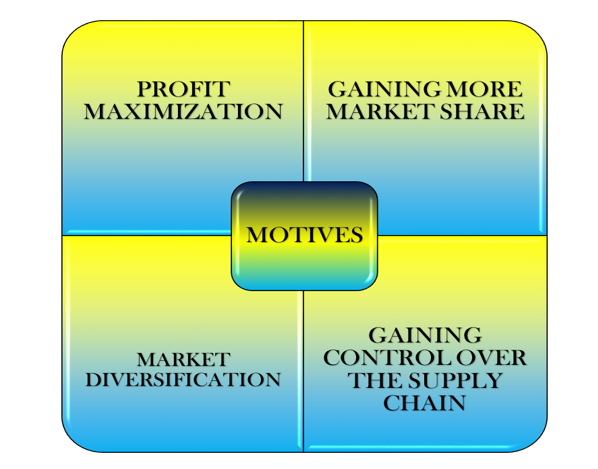EC7071 Econ of Organisation Assignment Sample
EC7071 Econ of Organisation Assignment Sample
Introduction
This report on vertical integration discusses what it means about vertical integration. The vertical integration discussion report will include various types of features, advantages, and disadvantages which show the actual importance and utilization of Vertical integration. Various motives will also be discussed in this report that leads to vertical integration.
About Vertical Integration
Vertical integration is a technique that helps a business to streamline operations by thinking about direct ownership of various production-process stages rather than relying on third-party vendors or contractors.
How vertical integration works
When a business tries to expand beyond the production or supply chain operations, vertical integration occurs or functions (Boehm and Sonntag, 2023). A corporation engages in vertical integration to become increasingly dependent on the other process components rather than attaching to a single point and the processes. Netflix is a perfect example of vertical integration.
This company started off renting DVDs before evolving into an internet streaming service for movies and movies with major studio licenses. After that, Netflix officials acknowledged that by producing some of their own original material, like the popular dramas Stranger Things and Grace & Frankie, they may be increasing their margins. It also provided some bravado, such as Get the Down from 2016, which apparently earns the studio 120 million.
The firm now uses its distribution approach, with the consent of the programming studios, to promote original content. In order to get more active in the early creation of entertainment, Netflix achieved vertical integration.
Reason for using Vertical Integration
The companies use vertical integration to have more control over their supply chain of the manufacturing process.
Types of Vertical integration
Three types of vertical integration are used mainly in multiple organizations — Forward, Backward, and Balanced Vertical Integration.
Definition of various Vertical Integration
Forward Vertical Integration: In this type of Vertical Integration a company essentially buys or merges with its customers. For example, EA sports Manufactures and develops video games. As it sits at the heart of the supply chain, if it were to acquire a shop like Gamestop or Target, forward vertical integration may take place.
Backward Vertical Integration: In this type of Integration a company can join with another company it is the stage before itself in Supply Chain. For instance, Ikea is based on wood manufacturers, while it is integrated with producers.
Balanced Vertical Integration: This kind of Integration is a mixture of forward and Backward Vertical integration. In this type of Vertical Integration, a company can merge with both the companies that are before it in distribution networks. All the section of the vertical integration issues is discussed in the next section of this report.
Issues of vertical integration
Expenses are the main problem with vertical integration. Several businesses should spend a lot of money setting up or buying factories. To preserve productivity and profit margins, they need also to retain the operating plants.
If a corporation acquires a retailer for the creation of their product and a physical shop that retains the old products as well, that reduces the company’s flexibility. This needs investment and time to move production to another product. If the suppliers who integrated are now only suppliers, then it decreases the flexibility of a company. It has invested and waited in the production movement (Loertscher and Marx, 2022). Therefore, if a company has various suppliers that specialize in different products, then it might be capable to go forward than having to invest in time production movement.
To reduce this issue or problem it is very crucial to implement a concise and clear structure of the organization. This will help to provide the responsibilities and role are clearly defined and that employee understands their role and how they fit within a company.
Vertical Integration may be costly due to its high costs. Not just the money spent, but also the work and effort required to purchase a new combined company. They might be closer to purchasing a business or firm because there might be added expenses like relocating plants and other facilities.
The business should concentrate on cost-effectiveness and productivity to minimize these problems. This may include methods to identify places where costs can be reduced and analyses of existing operations.
 Figure 1: Issues of Vertical Integration (Source: Self-created)
Figure 1: Issues of Vertical Integration (Source: Self-created)
Issues with management running a production company are very different from those running a storefront store (Görgün, et al. 2022). A good manufacturer does not necessarily result from a successful merchant. In that scenario, few current administrations could be retained on board to provide assistance. As a result, it may be very challenging for them to operate in a new setting where they can defend the parent business.
When a business transitions from being autonomous to being instructed what to do, conflicts may arise, particularly if the parent company has less experience in the sector. Those who work for the provider are probably being very precise right now.
To address this issue it is very crucial to provide soem clear objectives are fixed and that workers are held accountable for meeting them.
The defeat of focus, a new company integration is lots of work. Company integration is at a different stage in the supply chain and is very tuff, specifically because of less knowledge in that field. In this situation, a company’s management might find it difficult to focus on its core skills in favor of managing and integrating the new business (Sgroi and Sciancalepore, 2022). Due to the fact that they can develop into more work than they are worth, businesses typically sell off divisions within their organization.
To prevent this issue it is crucial to fix objectives and goals for the organization. It is important to assure that employees are conscious of goals and that they comprehend how individual responsibilities and roles contribute overall organization’s success.
Various motives can lead to vertical integration
Vertical integration is a process that focuses on handling the supply chain from the begging of the production process to the end customers. It is a part of the control of the corporate that is exercised while the company makes a decision either acquire a supplier or a consumer. A company can be considered vertical integration for several reasons, including the increase of profit, desired, earning control on the supply chain, diversifying into the market, and increasing its share of the market.
Profit maximization is the main goal of vertical integration. A business may take advantage of economies of scale and cut expenses by being in complete control of the production process. Eliminating intermediaries, optimizing manufacturing procedures, and making greater use of resources can all help achieve this (Yuan, et al. 2022). Vertical integration can also result in more distinct product offerings, which can enable a business to set higher pricing and generate bigger profits.
Gaining control over the supply chain is a further justification for vertical integration. A business may guarantee that the entire manufacturing process is controlled successfully and economically by managing both the supplier and the client. This can lessen the chance of supply interruptions and guarantee a constant level of quality. It can also assist in lowering the price of raw materials, which will benefit a company’s bottom line.
Gaining more market share is the third justification for vertical integration. A corporation can increase its share of the market by having influence over both the supplier and the customer (Sidhu, et al. 2022). This may be accomplished by providing customers with better offers, such as reduced costs or improved service. A business may also employ vertical integration to grow its client base and enter new markets.
Finally, vertical integration may be applied to market diversification. A business can access new markets and goods by buying a supplier or a customer. Due to the company’s existing position in the industry, this might help to lower the risk involved with entering new markets. Moreover, it might give access to fresh revenue streams and help to establish loyalty of the brand.
 Figure 2: Motives to Vertical Integration (Source: Self-created)
Figure 2: Motives to Vertical Integration (Source: Self-created)
Companies can utilize vertical integration as a strategy to increase earnings, take control of the supply chain, expand their market share, and diversify into new areas. A business may generate economies of scale, lower expenses, and increase its market share by controlling both the supplier and the consumer. Moreover, it can open doors to fresh revenue streams and promote brand loyalty (Hansen, et al. 2022). Ultimately, a business may grow earnings and acquire a competitive edge over its rivals by managing the complete manufacturing process from beginning to end.
Therefore in the last section of this report, it can be considered that Vertical Integration can permit a company to extend geographically by counting supply chain areas or by acquiring a new brand. Additionally, the Vertical Integration which is followed by company should aware of some principles which also lead to vertical Integration— certainty of demand for the company’s products, investment costs, adequate manufacturing facilities availability, and need for a higher share market that already shares above.
Conclusion
The Vertical Integration report has concluded that the report has discussed four main issues fop Vertical integration and about Vertical integration, also four types of motives are discussed in this report which helps to understand the reason for using Vertical Integration.
Reference List
Journals
Hansen, B., Miller, K. and Weber, C., 2022. Vertical integration and production inefficiency in the presence of a gross receipts tax. Journal of Public Economics, 212, p.104693.
Leuffen, D., Rittberger, B. and Schimmelfennig, F., 2022. Integration and Differentiation in the European Union: Theory and Policies. Springer Nature.
Loertscher, S. and Marx, L.M., 2022. Incomplete information bargaining with applications to mergers, investment, and vertical integration. American Economic Review, 112(2), pp.616-649.
Niemczyk, J., Sus, A., Borowski, K., Jasiński, B. and Jasińska, K., 2022. The Dominant Motives of Mergers and Acquisitions in the Energy Sector in Western Europe from the Perspective of Green Economy. Energies, 15(3), p.1065.
Richards, M.R., Seward, J.A. and Whaley, C.M., 2022. Treatment consolidation after vertical integration: Evidence from outpatient procedure markets. Journal of Health Economics, 81, p.102569.
Sgroi, F. and Sciancalepore, V.D., 2022. Dynamics of structural change in agriculture, transaction cost theory and market efficiency: The case of cultivation contracts between agricultural enterprises and the food industry. Journal of Agriculture and Food Research, 10, p.100396.
Sidhu, M., Pollard, J. and Sussex, J., 2022. Vertical integration of primary care practices with acute hospitals in England and Wales: why, how and so what? Findings from a qualitative, rapid evaluation. BMJ open, 12(1), p.e053222.
Yuan, C., Geng, C., Sun, J. and Cui, H., 2022. Vertical integration and corporate value under uncertainty shock: Evidence from the COVID-19 pandemic. China Economic Quarterly International, 2(4), pp.239-251.
Know more about UniqueSubmission’s other writing services:

